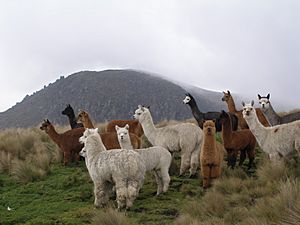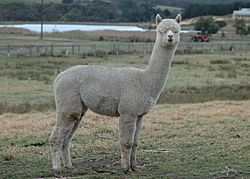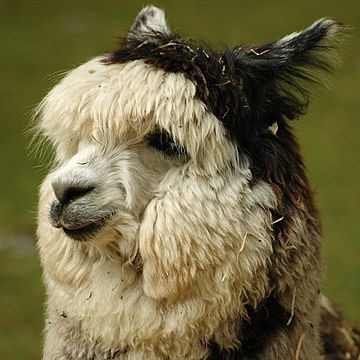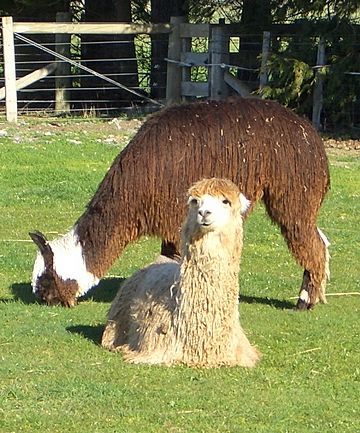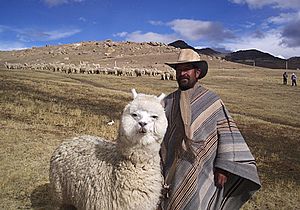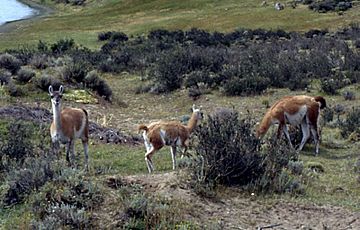Alpaca facts for kids
Quick facts for kids Alpaca |
|
|---|---|
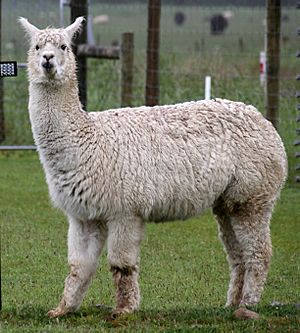 |
|
| Conservation status | |
| Scientific classification | |
| Genus: |
Lama
|
| Species: |
pacos
|
 |
|
| Alpaca range | |
| Synonyms | |
|
Camelus pacos Linnaeus, 1758 |
|
The alpaca (Lama pacos) is a species of South American camelid mammal. It is similar to, and often confused with, the llama. However, alpacas are often noticeably smaller than llamas. There are two breeds of alpaca: the Suri alpaca and the Huacaya alpaca.
Contents
Origin and domestication
Alpacas were domesticated thousands of years ago. There are no known wild alpacas, and its closest living relative, the vicuña (also native to South America), is the wild ancestor of the alpaca.
Remains of vicuña and guanaco have been found throughout Peru for around 12,000 years. Their domesticated counterparts, the llama and alpacas, have been found mummified in the Moquegua valley, in the south of Peru, dating back 900 to 1000 years. Mummies found in this region show two breeds of alpacas.
Breeds
The alpaca comes in two breeds, Suri and Huacaya, based on their fibers rather than scientific or European classifications.
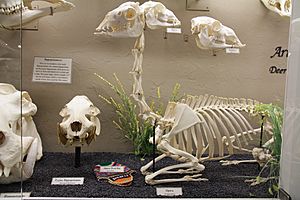
Huacaya alpacas are the most commonly found, constituting about 90% of the population. The Huacaya alpaca is thought to have originated in post-colonial Peru. This is due to their thicker fleece which makes them more suited to survive in the higher altitudes of the Andes after being pushed into the highlands of Peru with the arrival of the Spanish.
Suri alpacas represent a smaller portion of the total alpaca population, around 10%. They are thought to have been more prevalent in pre-Columbian Peru since they could be kept at a lower altitude where a thicker fleece was not needed for harsh weather conditions.
Description
An adult alpaca generally is between 81 and 99 centimetres (32 and 39 inches) in height at the shoulders (withers). They usually weigh between 48 and 90 kilograms (106 and 198 pounds). Raised in the same conditions, the difference in weight can be small with males weighting around 22.3 kilograms (49 lb 3 oz) and females 21.3 kilograms (46 lb 15 oz).
Habitat
Alpacas can be found throughout most of South America. They typically live in temperate conditions in the mountains with high altitudes. Alpacas are kept in herds that graze on the level heights of the Andes of Southern Peru, Western Bolivia, Ecuador, and Northern Chile at an altitude of 3,500 to 5,000 metres (11,000 to 16,000 feet) above sea level.
They are easy to care for since they are not limited to a specific type of environment. Animals such as flamingos, condors, spectacled bears, mountain lions, coyotes, llamas, and sheep live near alpacas when they are in their natural habitat.
Behavior
Alpacas are social herd animals that live in family groups, consisting of a territorial alpha male, females, and their young ones. Alpacas warn the herd about intruders by making sharp, noisy inhalations that sound like a high-pitched bray. The herd may attack smaller predators with their front feet and can spit and kick. Their aggression towards members of the canid family (coyotes, foxes, dogs etc.) is exploited when alpacas are used as guard llamas for guarding sheep.
Alpacas can sometimes be aggressive, but they can also be very gentle, intelligent, and extremely observant. For the most part, alpacas are very quiet, but male alpacas are more energetic when they get involved in fighting with other alpacas. When they prey, they are cautious but also nervous when they feel any type of threat. They can feel threatened when a person or another alpaca comes up from behind them.
Alpacas set their own boundaries of "personal space" within their families and groups. They make a hierarchy in some sense, and each alpaca is aware of the dominant animals in each group.
When they are young, they tend to follow larger objects and to sit near or under them. An example of this is a baby alpaca with its mother. This can also apply when an alpaca passes by an older alpaca.
Communication
Alpacas communicate through body language. The most common is spitting to show dominance when they are in distress, fearful, or feel agitated. Another example of their body communication includes a pose named broadside, where their ears are pulled back and they stand sideways. This pose is used when male alpacas are defending their territory.
Male alpacas are more aggressive than females, and tend to establish dominance within their herd group. In some cases, alpha males will immobilize the head and neck of a weaker or challenging male in order to show their strength and dominance.
Sounds
Alpacas make a variety of sounds:
- Humming: When alpacas are born, the mother and baby hum constantly. They also hum as a sign of distress, especially when they are separated from their herd. Alpacas may also hum when curious, happy, worried or cautious.
- Snorting: Alpacas snort when another alpaca is invading its space.
- Grumbling: Alpacas grumble to warn each other. For example, when one is invading another's personal space, it sounds like gurgling.
- Clucking: Similar to a hen's cluck, alpacas cluck when a mother is concerned for her cria. Male alpacas cluck to signal friendly behavior.
- Screaming: Their screams are extremely deafening and loud. They will scream when they are not handled correctly or when they are being attacked by a potential enemy.
- Screeching: A bird-like cry, presumably intended to terrify the opponent. This sound is typically used by male alpacas when they are in a fight over dominance. When a female screeches, it is more of a growl when she is angry.
Spitting
Not all alpacas spit, but all are capable of doing so. "Spit" is somewhat euphemistic; occasionally the projectile contains only air and a little saliva, although alpacas commonly bring up acidic stomach contents (generally a green, grassy mix) and project it onto their chosen targets. Spitting is mostly reserved for other alpacas, but an alpaca will also occasionally spit at a human.
Spitting can result in what is called "sour mouth". Sour mouth is characterized by "a loose-hanging lower lip and a gaping mouth."
Alpacas can spit for several reasons. A female alpaca spits when she is not interested in a male alpaca, typically when she thinks that she is already impregnated. Both sexes of alpaca keep others away from their food, or anything they have their eyes on. Most give a slight warning before spitting by blowing air out and raising their heads, giving their ears a "pinned" appearance.
Some signs of stress which can lead to their spitting habits include: humming, a wrinkle under their eye, drooling, rapid breathing, and stomping their feet. When alpacas show any sign of interest or alertness, they tend to sniff their surroundings, watch closely, or stand quietly in place and stare.
Training
Alpacas are generally very trainable and usually respond to reward, most commonly in the form of food. They can usually be petted without getting agitated, especially if one avoids petting the head or neck. Alpacas are usually quite easy to herd, even in large groups. However, during herding, it is recommended for the handler to approach the animals slowly and quietly, as failing to do so can result in danger for both the animals and the handler.
Reproduction
A male is usually ready to mate for the first time between two and three years of age. It is not advisable to allow a young female to be bred until she is mature and has reached two-thirds of her mature weight. As the age of maturation varies greatly between individuals, it is usually recommended that novice breeders wait until females are 18 months of age or older before initiating breeding.
Alpacas can breed at any time throughout the year but it is more difficult to breed in the winter. Most breed during autumn or late spring. The most popular way to have alpacas mate is pen mating. Pen mating is when they move both the female and the desired male into a pen. Another way is paddock mating where one male alpaca is let loose in the paddock with several female alpacas.
The gestation period is, on average, 11.5 months, and usually results in a single offspring, or cria. Twins are rare, occurring about once per 1000 deliveries. Cria are generally between 15 and 19 pounds, and are standing 30 to 90 minutes after birth. After a female gives birth, she is generally receptive to breeding again after about two weeks. Crias may be weaned through human intervention at about six months old and 60 pounds, but many breeders prefer to allow the female to decide when to wean her offspring; they can be weaned earlier or later depending on their size and emotional maturity.
Population
Alpacas are native to Peru, but can be found throughout the globe in captivity. Peru currently has the largest alpaca population, with over half the world's animals. The population declined drastically after the Spanish Conquistadors invaded the Andes mountains in 1532, after which 98% of the animals were destroyed. The Spanish also brought with them diseases that were fatal to alpacas.
European conquest forced the animals to move higher into the mountains, which remained there permanently. Although alpacas had almost been wiped out completely, they were rediscovered sometime during the 19th century by Europeans. After finding uses for them, the animals became important to societies during the industrial revolution.
Diet
Alpacas chew their food which ends up being mixed with their cud and saliva and then they swallow it. Alpacas usually eat 1.5% of their body weight daily for normal growth. They mainly need pasture grass, hay, or silage but some may also need supplemental energy and protein foods and they will also normally try to chew on almost anything (e.g. empty bottle). Most alpaca ranchers rotate their feeding grounds so the grass can regrow and fecal parasites may die before reusing the area. Pasture grass is a great source of protein. When seasons change, the grass loses or gains more protein. For example, in the spring, the pasture grass has about 20% protein while in the summer, it only has 6%. They need more energy supplements in the winter to produce body heat and warmth. They get their fiber from hay or from long stems which provides them with vitamin E. Green grass contains vitamin A and E.
Alpacas can eat natural unfertilized grass; however, ranchers can also supplement grass with low-protein grass hay. To provide selenium and other necessary vitamins, ranchers will feed their domestic alpacas a daily dose of grain to provide additional nutrients that are not fully obtained from their primary diet. Alpacas may obtain the necessary vitamins in their native grazing ranges.
Digestion
Alpacas, like other camelids, have a three-chambered stomach; combined with chewing cud, this three-chambered system allows maximum extraction of nutrients from low-quality forages. Alpacas are not ruminants, pseudo-ruminants, or modified ruminants, as there are many differences between the anatomy and physiology of a camelid and a ruminant stomach.
Alpacas will chew their food in a figure eight motion, swallow the food, and then pass it into one of the stomach's chambers. The first and second chambers (called C1 and C2) are anaerobic fermentation chambers where the fermentation process begins. The alpaca will further absorb nutrients and water in the first part of the third chamber. The end of the third chamber (called C3) is where the stomach secretes acids to digest food and is the likely place where an alpaca will have ulcers if stressed.
Poisonous plants
Many plants are poisonous to the alpaca, including the bracken fern, Madagascar ragwort, oleander, and some azaleas. In common with similar livestock, others include acorns, African rue, agave, amaryllis, autumn crocus, bear grass, broom snakeweed, buckwheat, ragweed, buttercups, calla lily, orange tree foliage, carnations, castor beans, and many others.
Use
Alpacas are considerably smaller than llamas, and unlike llamas, they were not bred to be working animals, but were bred specifically for their fiber. Alpaca fiber is used for making knitted and woven items, similar to sheep's wool. These items include blankets, sweaters, hats, gloves, scarves, a wide variety of textiles, and ponchos, in South America, as well as sweaters, socks, coats, and bedding in other parts of the world. The fiber comes in more than 52 natural colors as classified in Peru, 12 as classified in Australia, and 16 as classified in the United States.
In the textile industry, "alpaca" primarily refers to the hair of Peruvian alpacas, but more broadly it refers to a style of fabric originally made from alpaca hair, such as mohair, Icelandic sheep wool, or even high-quality wool from other breeds of sheep. In trade, distinctions are made between alpacas and the several styles of mohair and luster.
Alpacas and llamas have also started showing up in U.S. nursing homes and hospitals as trained, certified therapy animals. The Mayo Clinic says animal-assisted therapy can reduce pain, depression, anxiety, and fatigue. This type of animal therapy is growing in popularity, and there are several organizations throughout the United States that participate.
Fiber
Alpaca fleece is soft and possesses water and flame resistant properties, making it a valuable commodity.
Alpacas are typically sheared once per year in the spring. Each shearing produces approximately 2.3 to 4.5 kilograms (5 to 10 pounds) of fiber per alpaca. An adult alpaca might produce 1.4 to 2.6 kilograms (50 to 90 ounces) of first-quality fiber as well as 1.4 to 2.8 kilograms (50 to 100 ounces) of second- and third-quality fiber. The quality of alpaca fiber is determined by how crimpy it is. Typically, the greater the number of small folds in the fiber, the greater the quality.
Cultural presence
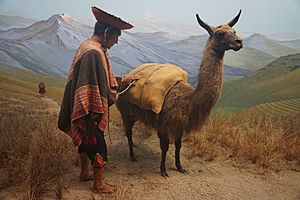
Alpacas are closely tied to cultural practices for Andeans people. Prior to colonization, the image of the alpaca was used in rituals and in their religious practices. Since the people in the region depended heavily on these animals for their sustenance, the alpaca was seen as a gift from Pachamama. Alpacas were used for their meat, fibers for clothing, and art, and their images in the form of conopas.
Conopas take their appearance from the Suri alpacas, with long locks flanking their sides and bangs covering the eyes, and a depression on the back. This depression is used in ritual practices, usually filled with coca leaves and fat from alpacas and lamas, to bring fertility and luck. While their use was prevalent before colonization, the attempts to convert the Andean people to Catholicism led to the acquisition of more than 3,400 conopas in Lima alone.
The origin of alpacas is depicted in legend; the legend states they came to be in the world after a goddess fell in love with a man. The goddess' father only allowed her to be with her lover if he cared for her herd of alpacas. On top of caring for the herd, he was to always carry a small animal for his entire life. As the goddess came into our world, the alpacas followed her. Everything was fine until the man set the small animal down, and the goddess fled back to her home. On her way back home, the man attempted to stop her and her herd from fleeing. While he was not able to stop her from returning, he was able to stop a few alpacas from returning. These alpacas who did not make it back are said to be seen today in the swampy lands in the Andes waiting for the end of the world, so they may return to their goddess.
Interesting facts about alpacas
- Alpacas and llamas are closely related and can successfully crossbreed.
- Both species are believed to have been domesticated from their wild relatives, the vicuña and guanaco.
- Recent DNA testing showed that the alpaca is descended from the vicuña, not the guanaco.
- The Moche people of Northern Peru often used alpaca images in their art.
- Alpacas can spit up to ten feet if they need to. For example, if another animal does not back off, the alpaca will throw up its stomach contents, resulting in a lot of spit.
- The average lifespan of an alpaca is between 15 and 20 years, and the longest-lived alpaca on record is 27 years.
- Alpacas need to eat 1–2% of body weight per day, so about two 27 kg (60 lb) bales of grass hay per month per animal.
- Alpacas have only lower teeth at the front of their mouths; therefore, they do not pull the grass up by the roots.
See also
 In Spanish: Vicugna pacos para niños
In Spanish: Vicugna pacos para niños


